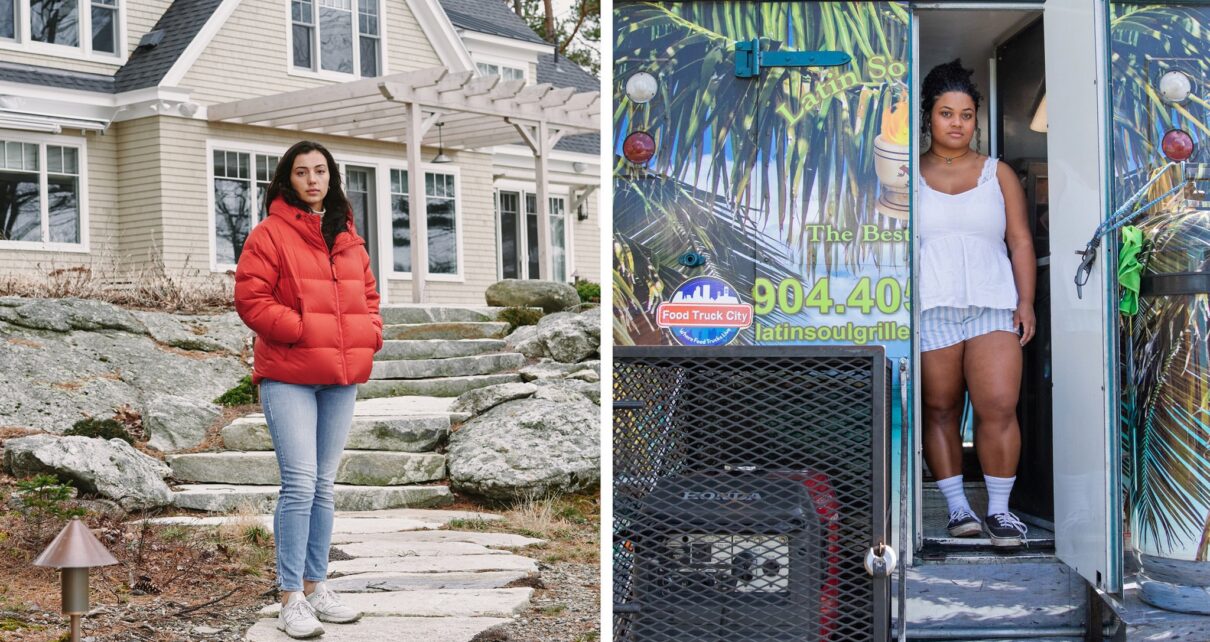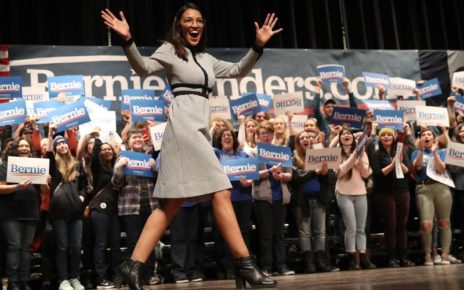The political science class was called “Forced Migration and Refugees.” Students read accounts of migrants fleeing broken economies and seeking better futures, of life plans drastically altered and the political forces that made it all seem necessary.
Then suddenly, the subject matter became personal: Haverford College shut down and evicted most students from the dormitories as the coronavirus spread through Pennsylvania.
Like many college courses around the country, the class soldiered on. The syllabus was revised. The students reconvened on a videoconferencing app.
But as each logged in, not everyone’s new reality looked the same.
One student sat at a vacation home on the coast of Maine. Another struggled to keep her mother’s Puerto Rican food truck running while meat vanished from Florida grocery shelves. As one young woman’s father, a private equity executive, urged the family to decamp to a country where infections were falling, another student’s mother in Russia couldn’t afford the plane ticket to bring her daughter home.
“Now Russia is about to close its borders,” Sophie Chochaeva told her classmates, in the days before the country did. She was one of 135 students still on campus, in a dorm room she called “the cozy foxhole,” as the world outside became a ghost town. “This crisis is exposing that a lot of people don’t have anywhere to go.”
The outbreak of the coronavirus — and the accompanying economic devastation that has left 10 million people almost instantly unemployed — has put America’s class divide on full display. Gig employees were the first to suffer, with many of their jobs vanishing without unemployment benefits. Office employees retreated to work-from-home arrangements while janitors cleaned the buildings they fled and delivery workers brought packages to their doorsteps.
But college was meant to be different. For decades, small liberal arts schools like Haverford, a short ride from Philadelphia, prided themselves on being the “great equalizer,” offering pedigrees not just to the scions of East Coast elites but also to the children of first-generation immigrants. Scholarships filled in for family money. Students ate the same cafeteria food in the morning and bunked in the same creaky beds at night.
No longer — at least not while the virus spreads through the country.
“It’s as though you had a front-row view on American inequality and the ways in which it was disguised and papered over,” said Anita Isaacs, the course’s professor who has taught political science at Haverford since 1988. The first gulf war, the Sept. 11 attacks, the Great Recession — she had seen them all through the eyes of her students.
“There’s been nothing like this before,” she said.
Several nights before the class was to reconvene online in late March, Professor Isaacs received an email from one of her teaching assistants, Tatiana Lathion, a college senior whose parents own the food truck. Their source of income was on the verge of liquidation as stay-at-home orders loomed in Jacksonville, Fla., where they lived.
“I’m not sure my savings will allow them both to survive this quarantine and still keep the business,” she wrote. She said she was thinking of getting a part-time job at a grocery store.
Wasn’t college supposed to get her away from all that?
“I have this panic moment that it’s literally for nothing now,” Ms. Lathion wrote to her professor.
Ms. Lathion had not thought she would attend college.
Her mother had grown up in Puerto Rico before moving to Indiana and then Florida, and while she had sought out good public schools for her children, she didn’t push for education beyond that. But Ms. Lathion had high grades and a college counselor suggested that she apply to QuestBridge, a nonprofit that matches low-income students with colleges offering full-tuition scholarships.
As some high school seniors traveled the East Coast touring potential schools, Ms. Lathion asked her guidance counselor to pick out colleges that she thought would be a good fit.
“I didn’t think I was going to get that scholarship,” she said, so it was a surprise to her when Haverford came back with a full ride. She had to learn where it was.
“I was Googling Haverford, and was like, ‘Oh, I’m going to Pennsylvania, Mom,’” she said.
If Ms. Lathion found Haverford by chance, the school’s recruitment of underprivileged students like her was more by design.
The college was founded by Quakers in the 1830s and has a history of preaching equality and social justice. While tuition hovers around $73,000 a year, families earning less than $60,000 are exempted from taking out loans. By some metrics Haverford did better than most Ivy League schools in bringing in low- and middle-income students, despite having a far smaller endowment.
Sensing the doors wide open, Ms. Lathion plunged into playing on the lacrosse team. The sport was dominated by white, upper-class players who often learned at Northeast prep schools, but the Haverford team quickly made a place on the field for Ms. Lathion, who had learned to play in Florida.
The players wore the same uniforms, and even chose to live together on an apartment floor.
But while her teammates vacationed or completed internships, Ms. Lathion spent her summers helping her parents make empanadas at their Florida food truck. In a text message chat last winter break, her teammates discussed Christmas plans with their families. Ms. Lathion revealed she was in Puerto Rico, staying with hers after a powerful earthquake.
“She would send texts to the team group chat and say ‘Fifth day without power, hope you’re enjoying break!’” said Isabel Canning, a junior who played on the team. “I would Snapchat her back and ask if everything was OK.”
Ms. Canning had Latin roots, too. Her mother emigrated from Portugal in the 1970s, then married into an established Maine family that ran a distribution business. Ms. Canning’s father ran the company before starting a consulting outfit of his own. Each summer the family headed to the seaside town of Boothbay, where Ms. Canning’s father had taught her to play lacrosse.
By late January, as the coronavirus was moving beyond China, Ms. Canning saw a message from Ms. Lathion saying she planned to be a teaching assistant that coming semester. The two teammates discovered they had both been recruited by Ms. Isaacs to assist with her seminar on forced migration from Latin America.
They were joined in class by Ms. Chochaeva, who as a child bounced between the homes of her separated parents, several subway stops from Moscow’s Red Square. She had taken English classes until her family could no longer afford them, and then taught herself. Before Haverford, she had never visited the United States.
Like Ms. Lathion, Ms. Chochaeva imagined her prospects would dramatically change by attending college. She remembered lying on the floor and staring up at the ceiling when she found out she had been accepted to Haverford.
“I felt like some kind of uncertainty ended, and a new kind of uncertainty began,” she said.
Chace Pulley was one of the first in the class to realize the virus was having a big impact. Her father, an investor, had a trip planned to Japan, where he did business. Schools were closing. As Asian markets began to crash, Ms. Pulley’s parents assured her they had plenty of cash on hand, a decision they made after the Great Recession.
Ms. Chochaeva had flashes of 2008, too. She was 9 when her mother lost her job in Russia and was forced into a pension; Ms. Chochaeva’s older brother, who suffered from a learning disability, developed diabetes, which required costly treatment. She remembered how food had disappeared from shelves, and called her mother to make sure she was fine.
On March 4, Ms. Isaacs had her students stand at a chalkboard to create an enormous diagram of all the concepts they had studied in class. Students packed in and stretched over one another to draw connections like “fear and insecurity” and “familial connections.” It would be the last time the class would gather like that.
During spring break in mid-March, Ms. Lathion and Ms. Canning were headed to a lacrosse game in Virginia that was suddenly canceled out of safety concerns. They had already been told Haverford was delaying the start of classes because of the virus; now came a message to students not to return that semester at all.
Ms. Canning’s family quickly brought her to their summer home after she car-pooled to Maine with another student, leaving a family Land Rover on campus. Ms. Canning is on immunosuppressant drugs for a condition she developed on an educational trip to Kenya. An uncle who worked at the family distribution business gave her masks and gloves.
Ms. Lathion returned home to find Latin Soul Grille, her family’s food truck and their only livelihood, was starting to fail. It was up to her to help keep it going. As the lacrosse players gathered up for a video conference Ms. Lathion arrived late; she’d spent the day on what she called a “scavenger hunt” to find what remaining meat was still available for the truck at grocery stores.
By then, Ms. Pulley had made it to her family’s home in Hillsborough, Calif., a wealthy community with sweeping views of the San Francisco Bay. Her father had wanted the family to come with him to Japan, where he had traveled for business in the past and where infections seemed to be subsiding, but they ultimately decided to stay in California.
Andreanna Papatheodorou, another student in the seminar, tried to move back in with her mother, who had once been an undocumented immigrant from Argentina. But the pandemic made her mother anxious, and it became too much for Ms. Papatheodorou, who decided to return to Haverford.
“I said one less person in and out is better for you guys,” she said, before returning to Pennsylvania. “If I get sick, you can’t take care of me.”
When the class meets on Wednesdays at 1:30 on the Zoom app, the students discuss the virus and the ways it will affect the migrants they were learning about before the outbreak. But the conversation increasingly works its way to their own fate.
“Both my parents are priests,” began Hannah Stanley, who had retreated to Baltimore. “They had to close the church. Now they’re wondering, after months of quarantine how long it will take for people to come back.”
Sofia Bomse, in New Mexico, was disheartened.
“I would like to think there will be a call for radical social change now, but I don’t think that’s going to happen,” she said. “The gap between the super rich and everyone else will widen.”
After class, Professor Isaacs thought back to the email that she had gotten from Ms. Lathion. She said after she read it, she called to make sure her student was all right.
“I watched her as she cried through this screen and I kept thinking if it weren’t for coronavirus, we would be sitting together and I’d be able to physically reach out,” she said. “And I couldn’t do any of that and it was devastating.”
She added: “It’s possible to believe that we can bridge inequalities by coming together on the Haverford campus, or that we can at least soften the edges — and then there is this incredible rupture. I’m very worried about what comes next for them.”
Source: College Made Them Feel Equal. The Virus Exposed How Unequal Their Lives Are.





